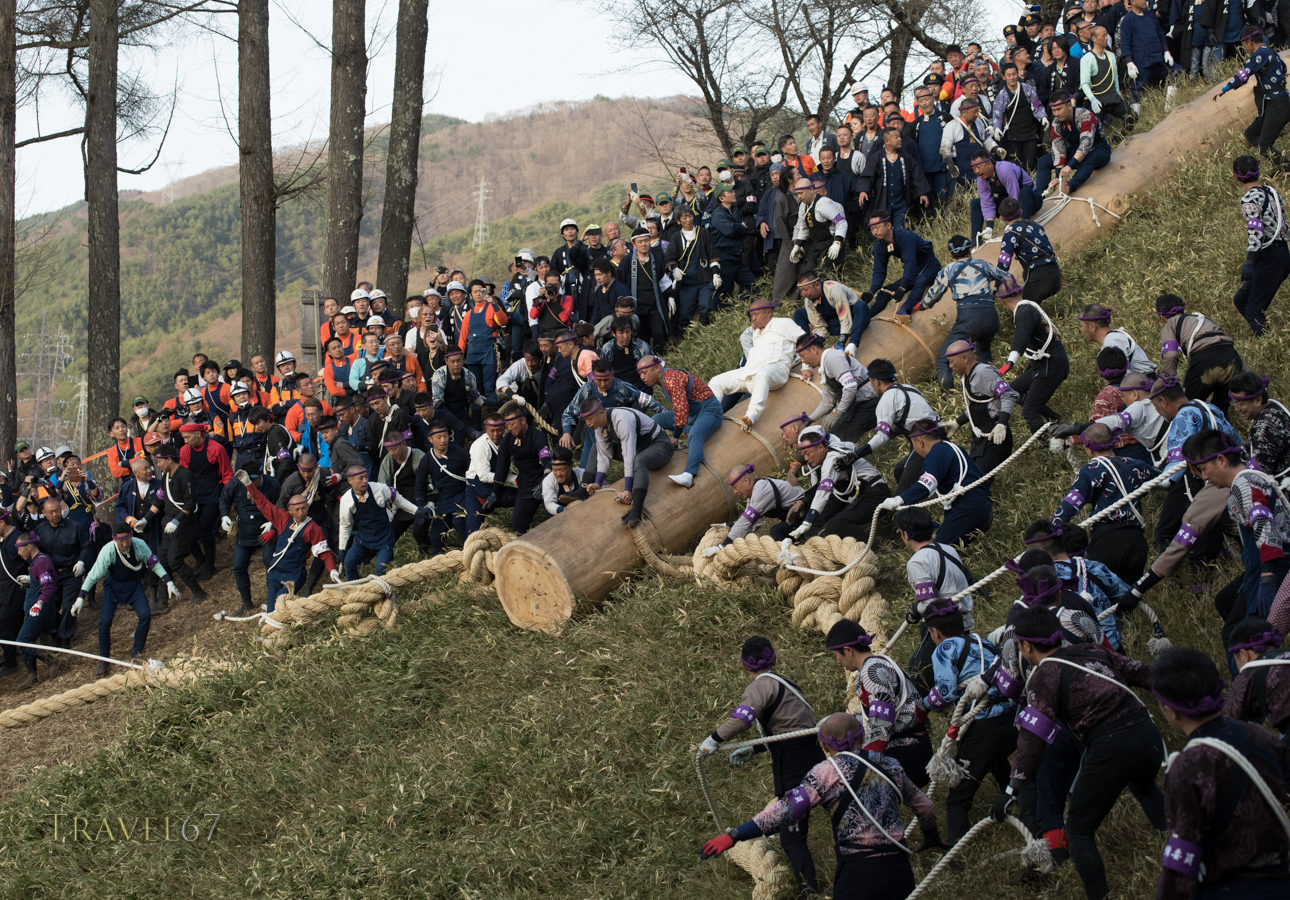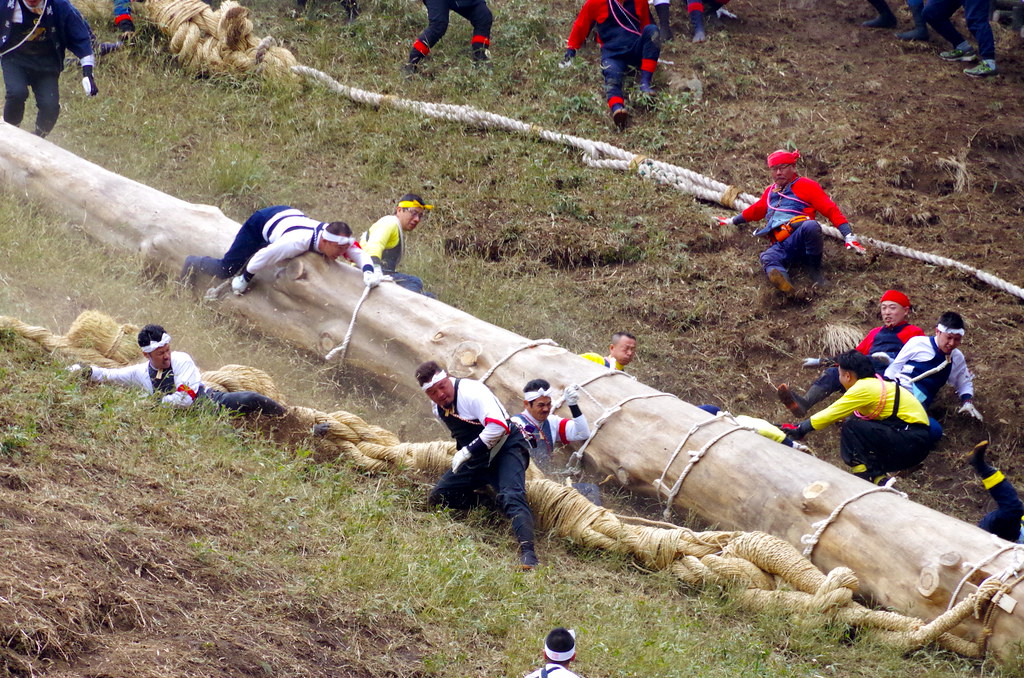30 December 2020
Onbashira: The Most Dangerous Festival in Japan
2016 was a special year in Japan. Every six years the men of the towns and villages around Lake Suwa in the Nagano Prefecture participate in the Onbashira festival (a matsuri in Japanese) and in 2016 it came round again. It has been celebrated sexenially for over 1,200 years without interruption.
Translated as ‘the honored pillars’, Onbashira symbolically renews the Suwa Taisha shrine and is a dazzling display of the power of man over nature. It is also known as the most dangerous festival in Japan. Broken limbs are inevitable during the festival and deaths have also, unfortunately, been recorded.

This festival would never happen elsewhere, frankly. Hordes of health and safety inspectors would ensure that the huge logs would become nothing more than twigs. As for riding atop them at a breath-taking speed – this would simply be banned, interdit, verboten. However, this is Japan. Have you ever seen any of the country’s game shows which make demands on the body which should make most people quail? You may have wondered where anyone could get the idea for such risky physicality. Perhaps their roots lie in Onbashira.
Image Credit
The festival is not a short one. The first part, Yamadashi, is in April and means ‘coming out of the mountains’. 16 tree trunks are taken from the local forest. They have been left to grow for 200 years for this very purpose and are simply immense. They are over 16 metres long and weight over 12 tonnes. There are four shrines at Suwa Taisha and each one requires a log at each of its corners.
Image Credit
When they emerge from the forest the huge logs are rested for a month.
Image Credit
Then they are decorated in traditional Shinto colors and teams of men drag the logs down the slopes of the mountain. Their destination is the four shrines of Suwa Taisha, one of the oldest Shinto shrines in existence. It dates back to the eighth century and its construction coincides with the emergence of Onbashira as a festival.
Image Credit
The side of the mountain is, at one point, at a gradient which precludes a gentle push and slide. This is the moment at which the bravest young men hoist themselves atop the logs and ride them down the perilous sides of the mountain.
Image Credit



This hair-raising experience has evolved in to a ceremony in its own right. It is known as Kiotoshi which means "tree falling". Although the trees do indeed ‘fall’ down the mountainside, it is the men who truly cascade.
Image Credit
Image Credit
The second part of the festival takes place in May and is known as Satobiki. This is the point at which the new logs which are intended to support the foundation of the shrine are raised. This is done by hand with a group of log bearers riding the log as it is raised, singing at the top of their voices. The song celebrates the successful raising of the log.
Image Credit
Image Credit
Image Credit
Image Credit
Image Credit
This can be made even more difficult that you might imagine by the presence of a water feature at one of the shrines.
This beautifully shot video by Oh! Matsuri captures the intensity of the ceremony beautifully - would you sit on the log?
Translated as ‘the honored pillars’, Onbashira symbolically renews the Suwa Taisha shrine and is a dazzling display of the power of man over nature. It is also known as the most dangerous festival in Japan. Broken limbs are inevitable during the festival and deaths have also, unfortunately, been recorded.

This festival would never happen elsewhere, frankly. Hordes of health and safety inspectors would ensure that the huge logs would become nothing more than twigs. As for riding atop them at a breath-taking speed – this would simply be banned, interdit, verboten. However, this is Japan. Have you ever seen any of the country’s game shows which make demands on the body which should make most people quail? You may have wondered where anyone could get the idea for such risky physicality. Perhaps their roots lie in Onbashira.
Image Credit
The festival is not a short one. The first part, Yamadashi, is in April and means ‘coming out of the mountains’. 16 tree trunks are taken from the local forest. They have been left to grow for 200 years for this very purpose and are simply immense. They are over 16 metres long and weight over 12 tonnes. There are four shrines at Suwa Taisha and each one requires a log at each of its corners.
Image Credit
When they emerge from the forest the huge logs are rested for a month.
Image Credit
Then they are decorated in traditional Shinto colors and teams of men drag the logs down the slopes of the mountain. Their destination is the four shrines of Suwa Taisha, one of the oldest Shinto shrines in existence. It dates back to the eighth century and its construction coincides with the emergence of Onbashira as a festival.
Image Credit
The side of the mountain is, at one point, at a gradient which precludes a gentle push and slide. This is the moment at which the bravest young men hoist themselves atop the logs and ride them down the perilous sides of the mountain.
Image Credit



This hair-raising experience has evolved in to a ceremony in its own right. It is known as Kiotoshi which means "tree falling". Although the trees do indeed ‘fall’ down the mountainside, it is the men who truly cascade.
Image Credit
Image Credit
The second part of the festival takes place in May and is known as Satobiki. This is the point at which the new logs which are intended to support the foundation of the shrine are raised. This is done by hand with a group of log bearers riding the log as it is raised, singing at the top of their voices. The song celebrates the successful raising of the log.
Image Credit
Image Credit
Image Credit
Image Credit
Image Credit
This can be made even more difficult that you might imagine by the presence of a water feature at one of the shrines.
This beautifully shot video by Oh! Matsuri captures the intensity of the ceremony beautifully - would you sit on the log?
























